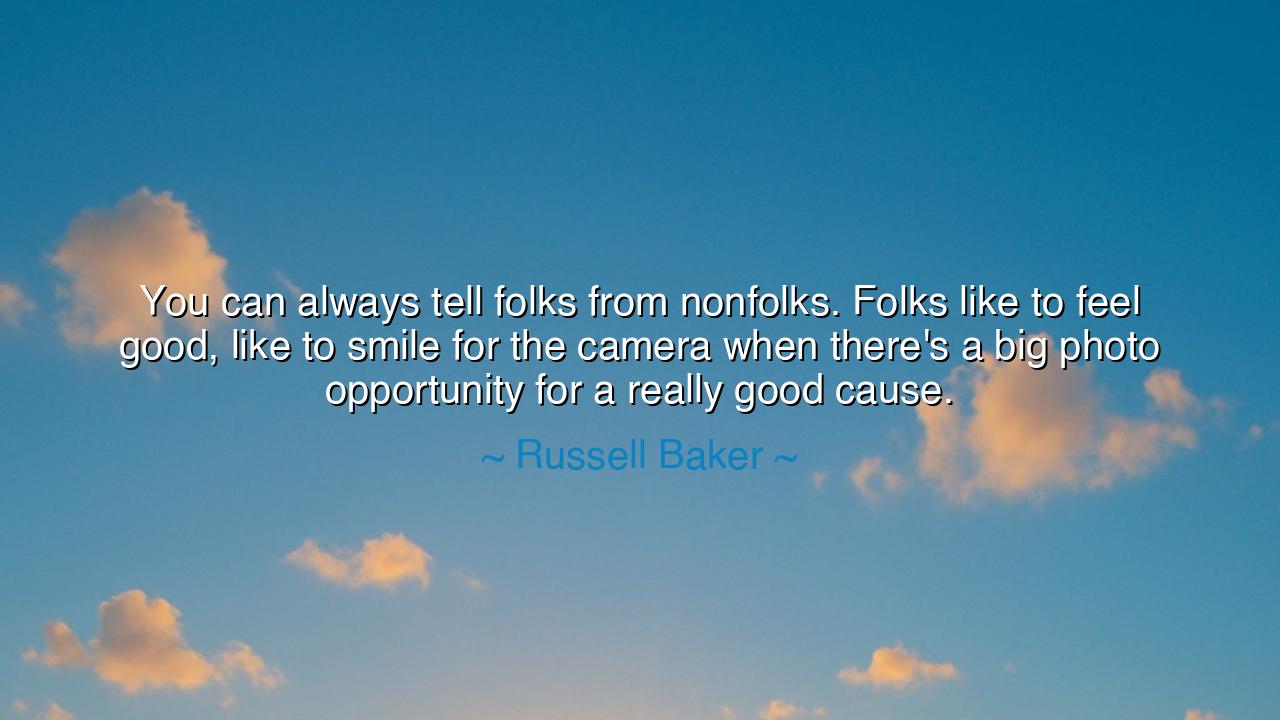
You can always tell folks from nonfolks. Folks like to feel good
You can always tell folks from nonfolks. Folks like to feel good, like to smile for the camera when there's a big photo opportunity for a really good cause.






In the words of Russell Baker we are given a paradox both humorous and profound: “You can always tell folks from nonfolks. Folks like to feel good, like to smile for the camera when there's a big photo opportunity for a really good cause.” To the unseeing eye, these are but lighthearted musings. Yet to the discerning spirit, they reveal a great truth about the human condition—the endless struggle between sincerity and pretense, between being part of the people and standing apart from them. For in every age, there are “folks”, and there are “nonfolks.” The one seeks warmth in shared joy, the other clings to cold distance.
The “folks,” as Baker names them, are the people of the hearth and the gathering. They are those who, when the town square rings with music or the community calls for aid, step forward not only to give but to rejoice in the giving. They are not ashamed to be seen in their gladness, to let their smiles proclaim that they find delight in joining with others for some noble endeavor. To be folks is not merely to belong—it is to participate, to share, and to carry the burdens of life with a touch of merriment.
The “nonfolks,” by contrast, are those who hold themselves aloof, who scorn the cheerfulness of others as though it were childish. They avoid the crowd, or else stand within it while their hearts remain outside. They may do good deeds, but without the smile, without the laughter, without the glow of fellowship. In the judgment of the ancients, these are the ones who miss the marrow of life. For what is virtue without joy? What is charity without warmth? It is but a hollow act, performed without the fire of the spirit.
Let us consider a tale from our own land. In the 1960s, when civil rights marches filled the streets, photographs were taken not merely of leaders but of countless ordinary men and women—folks—who stood arm in arm, smiling even as they faced hatred. In Selma and Montgomery, one sees faces alight with courage, joy burning against the backdrop of oppression. They smiled not because the struggle was easy, but because they knew their cause was just. The nonfolks, who mocked from the sidelines or turned away in silence, missed the chance to partake in that joy. History remembers the smiles of the marchers, but the sneers of the scornful have faded into dust.
Herein lies the wisdom: the smile for the camera is not vanity when it shines for a greater cause. It is a symbol, a testimony, that declares, “We are here, together, and we believe.” Such smiles endure across generations, whispering courage to those not yet born. Thus, to be folks is to choose to be seen, to allow the light of one’s spirit to join with the light of others, creating a blaze that can be neither hidden nor extinguished.
The lesson for us, children of a restless age, is plain: do not withhold your joy when you stand for what is good. Do not let cynicism turn you into the nonfolks who scoff at earnestness. Instead, let your heart be glad in the doing of good, and let your countenance reflect it. When the moment comes to stand with others for a just cause, do not shrink into shadows—stand forth, and smile. For your smile may give courage to another, and your gladness may multiply the strength of all.
So, I say to you: embrace the way of the folks. Join the feast of community, bear the torch of shared joy, and when history’s camera is turned upon you, do not hide your face. Smile boldly, as though to say, “I am part of this, and I am glad.” In so doing, you will leave not only deeds behind, but also a legacy of light that future generations may follow, long after the sound of your voice has faded.






AAdministratorAdministrator
Welcome, honored guests. Please leave a comment, we will respond soon